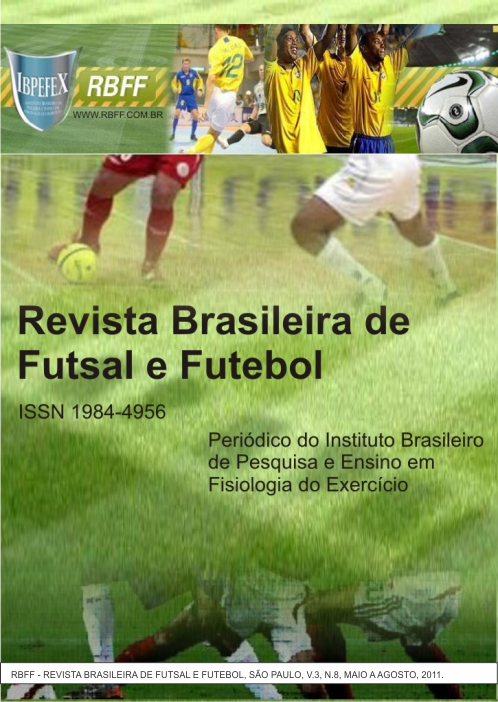The variations in the use of tactics of futsal goalkeepers lines there’s no change the result of the games São Paulo Cup
Abstract
Since the futsal as a team sport where the goalkeeper has a function of paramount importance in futsal but requires it to be anexpert, that’s why it’s the main subject of this study. Therefore, this study aims to collect and analyze variations in the use of tactics of futsalgoalkeepers line there’s no change in the score? If it occurs in a positive or negative way, when the goalkeeper and most commonly used online (score unfavorable, favorable or tie), based on the games Sao Paulo cup youth category in 2009 -SP, through sheet of observation (Scout), collecting data through observations. Making a review in literature and found Couto Souza (2004) that says in recent years the rules of futsal have been changing, with important repercussion in the performance of the goalkeeper. Initially, the goalkeeper had his goal area free to score goals. Later the goalkeeper was not allowed do use the hands to receive the ball from his companions, being forced to play with the feet. At last, the most significant change for the goalkeeper function, was the permission to play outside of his goal area with the feet, becoming the fifth player to participate actively in the tactics organization of the team. So this team has changed a lot its performance tactically and futsalbecame more offensive. For this study it was used a material was used as a worksheet as a material created for observations of entry and exit of the goalkeeper at the start line with the results found some tables were made that facilitated our discussion and it was measured through the sheet of observation, then we could conclude that input line of the goalkeeper is characterized mostly when the team has an unfavorable table score.
References
-Ferreira, R.L. Futsal e a Iniciação.5ª edição. Rio de Janeiro. Sprint. 2001.
-Greco, P.J.; Benda, R.N. Iniciação Esportiva Universal: metodologia da iniciação esportiva na escola e no clube. Vol. 2. Belo Horizonte. UFMG. 1998.
-Greco, P.J. Caderno de Rendimento do Atleta de Handebol. Belo Horizonte. Health. 2000.
-Mattos, J.G.C.; Salles, E.M. Futsal: alterações das regras e suas influências no processo de treino. Revista Mineira de Educação Física. Viçosa. Vol. 4. Núm. 1. p. 16-24. 1996.
-Mutti, D. Futsal: da iniciação ao alto nível. 2ª edição São Paulo. Phorte. 2003.
-Oliveira, R.L. Análise Técnico-Tática e Pontuação das Finalizações no Jogo de Futsal do Campeonato Brasileiro de Seleções, Categoria Juvenil em 2002-GO. 2002. Monografia Graduação em Educação Física. Escola de Educação Física, Fisioterapia e Terapia Ocupacional. UFMG. Belo Horizonte. 2002.
-Saad, M.; Costa, C.F. Futsal: movimentações defensivas e ofensivas. Florianópolis. Visual Books. 2001.
-Santos Filho, J.L. Manual de Futsal. Rio de Janeiro. Sprint. 1998.
-Souza, P.R.C. Conhecimento Tático no Futsal: um estudo comparativo. 1996. Monografia Graduação em Educação Física. Escola de Educação Física. UFMG. Belo Horizonte. 1996.
-Souza, P.R.C.; Leite, T.M.F. Futsal. In: Greco, P.J. Iniciação Esportiva Universal: metodologia da iniciação esportiva na escola e no clube. Vol. 2. p. 171-203. Belo Horizonte. UFMG. 1998.
-Tolussi, F.C. Futebol de Salão. São Paulo. 3ª edição Hemus. 1986.
-Voser, R. Futsal: princípios técnicos e táticos. Rio de Janeiro. Sprint. 2001.
Authors who publish in this journal agree to the following terms:
- Authors retain the copyright and grant the journal the right of first publication, with work simultaneously licensed under the Creative Commons Attribution License BY-NC which allows the sharing of the work with acknowledgment of the authorship of the work and initial publication in this journal.
- Authors are authorized to enter into additional contracts separately for non-exclusive distribution of the version of the work published in this journal (eg, publishing in institutional repository or book chapter), with acknowledgment of authorship and initial publication in this journal.
- Authors are allowed and encouraged to post and distribute their work online (eg, in institutional repositories or on their personal page) at any point before or during the editorial process, as this can bring about productive change as well as increase impact and impact. citation of published work (See The Effect of Free Access).





